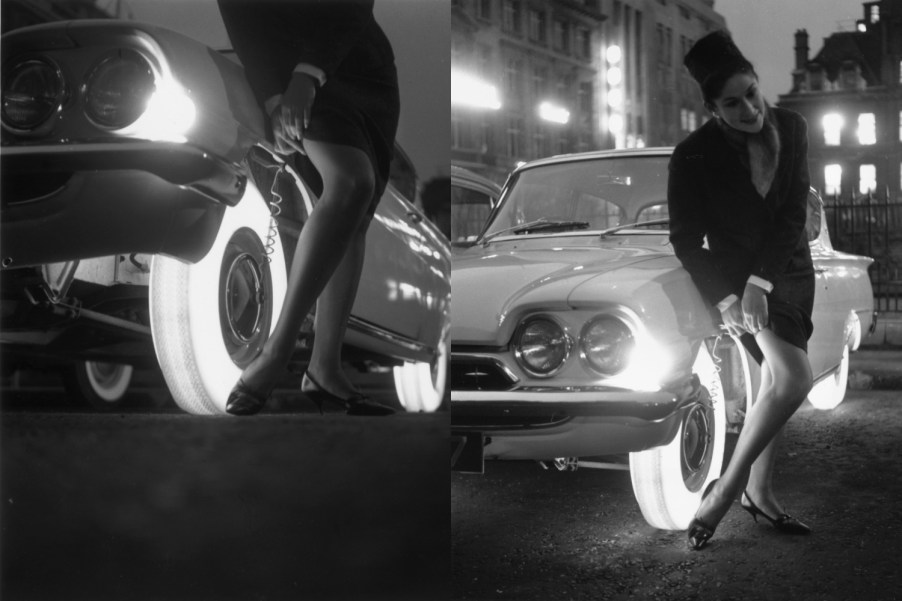
The Goodyear Illuminated Tire Prototype Frequently Melted but Was Cool to Look At
The 1960s were a wild time for humans and automobiles alike. Cars were huge, unsafe, and seatbelts didn’t become mandatory until the end of the decade, but that didn’t stop Goodyear illuminated tires from attempting to become a fad. Why didn’t these these illuminated tires become a more longlasting trend back in 1961?
How did Goodyear illuminated tires come about?

The Goodyear Tire & Rubber Company was having a good run of it back in the 1960s. The good ol’ days of rock and roll, fast food, and cars were in full swing, and Goodyear illuminated tires wanted to capitalize on all of the trends. Goodyear started looking toward the future and aimed to make the “tire of tomorrow.”
According to IEEE.org, an old company newsletter said the tires would be “one of the most dramatic tire developments in the history of the industry.” The glowing tires were made from a synthetic polyurethane rubber called Neothane. Neothane could be poured into tire-shaped molds and baked in an oven at 250°F (121°C).
Even though it sounds a bit complicated, Goodyear said the process to make Neothane tires was much easier than traditional tires. Traditional tires require layers of rubber and fabric along with a time-consuming production process. However, Goodyear said that the hardness of plastic and resilience of rubber found in the Neothane led to “outstanding resistance to abrasive wear, chipping, cutting, and tearing.” Back in 1961, this sounded like a great leap forward.
The Goodyear illuminated tires made from Neothane happened to be translucent
As if the Goodyear illuminated tires couldn’t get more interesting, Neothane was translucent. Goodyear decided to use this to the tire’s advantage and add dye to the rubber. This made the tires in various colors like blue, green, yellow, orange, and even red. By placing the illuminated tires on rims with lightbulbs inside, the tires glowed vividly after the sun went down. The glowing resembled neon lights from a sock hop party more than a method of transportation.
According to a press release from the tire maker back in the day, Goodyear had many planned uses for buyers.
“Auto stylists may use them to carry out a car’s color scheme, perhaps matching the tires with the upholstery. And it’s not at all unlikely that milady will want tires that enhance her wardrobe, her hair, or even her eyes. Imagine, if you will, one girl telling another: ‘But, my dear, green tires just don’t do a thing for your complexion.’”
Goodyear | IEEE.org
Goodyear hoped the tire would hit the market in a few years. It also expected it to be a new chapter for the company. Drivers could control the level of glowing from a panel mounted inside the car. This also allowed drivers to use the tires as turn signals and brake lights for extra fun.
Glowing tires were just ahead of the times

The initial testing was promising. The Goodyear illuminated tires were smooth and quiet on the roads. However, once the tire experienced wet weather or hot weather, it deteriorated from there. When drivers used the brakes frequently, such as in traffic, the tires started to melt. Some drivers found the illuminated tires distracting, especially at night.
According to a Life Magazine ad from 1990, Goodyear thought the illumination would make driving safer in fog or low-light conditions. “But when the tires have been lit in road tryouts, they have caused some confusion. Other motorists have been so enthralled by the pretty colors that they have cone through red lights or just stopped to stare.” Just after this article was an ad for GE lighted snowball lamps that glowed in the day and night, it was just a time for glowing features, it seems.
Unfortunately, further testing did not bode well for the Goodyear illuminated tires. Production ended up being more expensive than anticipated, and the tires didn’t hold up in various conditions. Techology has come a long way since then, so maybe glowing tires will make a comeback sometime soon.



